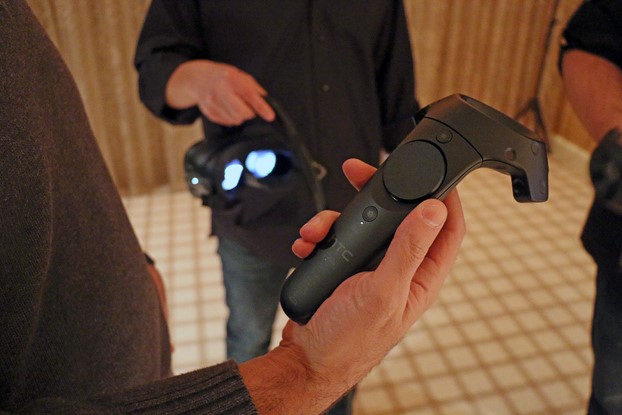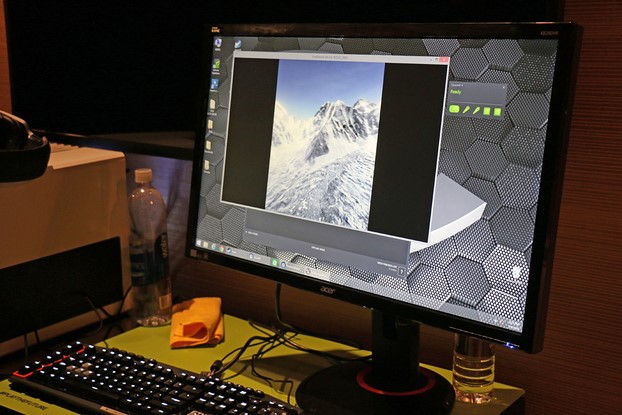NVIDIA SHIELD Updates And Climbing Mount Everest With The HTC Vive 2nd Edition VR Kit
NVIDIA held a press conference last night where it unveiled its latest autonomous driving technologies, like the next-gen Tegra and Pascal-powered Drive PX 2, but representatives from the company were also setup off-site talking about updates to their SHIELD Android TV device and various VR initiatives. We’ve got video from the press conference posted here, and Paul covered the details of NVIDIA’s new VR Ready program.
We can report that the SHIELD Android TV will be receiving an Android Marshmallow update in the not-too-distant future, complete with an updated and more customizable UI, better speech recognition, and some nuts-and-bolts updates like HDMI-CEC support than can both turn a TV on or off. As much as we dig the SHIELD TV around here, the most exciting time spent in NVIDIA’s suite was with the just-announced HTC Vive second generation developer edition VR kit.
We got to experiment with a handful of demos using the HTC Vive connected to an NVIDIA GeForce GTX Titan X powered system, including an immersive paint demo and an awesome simulation of climbing Mt. Everest, in what was undeniably the best virtual reality experience we’ve had thus far.
The new HTC Vive second generation headset features an updated design, with an integrated front facing camera for merging parts of the real-world environment into the virtual world, removable padding and facial inserts, brighter screens, and redesigned handheld controllers, which are now wireless.


Though we believe there is still some work to be done on the current-generation VR devices poised to hit the market soon, even at this stage of development, the HTC Vive is a compelling solution. As it exists today, we had a visceral reactions in the experience with the Vive in its current configuration during the Mt. Everest demo we were shown. Once higher resolution screens are integrated, combined with a less cumbersome tethering scheme, the experience is going to be even better.

The Mt. Everest demo simulates a climb up the iconic mountain. Part of the demo is narrated, but after some brief instructions the participant is able to freely explore and interact with the environment. At one point, you're asked to traverse a cavern across a thin, metal bridge, and Marco's legs failed him. He has an unhealthy fear of heights and his legs simply didn't want to move when it came time to step out onto the bridge. The demo was that convincing.
We can report that the SHIELD Android TV will be receiving an Android Marshmallow update in the not-too-distant future, complete with an updated and more customizable UI, better speech recognition, and some nuts-and-bolts updates like HDMI-CEC support than can both turn a TV on or off. As much as we dig the SHIELD TV around here, the most exciting time spent in NVIDIA’s suite was with the just-announced HTC Vive second generation developer edition VR kit.
We got to experiment with a handful of demos using the HTC Vive connected to an NVIDIA GeForce GTX Titan X powered system, including an immersive paint demo and an awesome simulation of climbing Mt. Everest, in what was undeniably the best virtual reality experience we’ve had thus far.
The new HTC Vive second generation headset features an updated design, with an integrated front facing camera for merging parts of the real-world environment into the virtual world, removable padding and facial inserts, brighter screens, and redesigned handheld controllers, which are now wireless.

The HTC Vive is being developed in partnership with Valve, and is currently due to be released in the April 2016 time frame. The new development kit is designed to be more closely aligned with the vision for the final shipping product and to allow developers to create or fine-tune their software and experiences well in advance of the consumer launch.

Though we believe there is still some work to be done on the current-generation VR devices poised to hit the market soon, even at this stage of development, the HTC Vive is a compelling solution. As it exists today, we had a visceral reactions in the experience with the Vive in its current configuration during the Mt. Everest demo we were shown. Once higher resolution screens are integrated, combined with a less cumbersome tethering scheme, the experience is going to be even better.

The Mt. Everest demo simulates a climb up the iconic mountain. Part of the demo is narrated, but after some brief instructions the participant is able to freely explore and interact with the environment. At one point, you're asked to traverse a cavern across a thin, metal bridge, and Marco's legs failed him. He has an unhealthy fear of heights and his legs simply didn't want to move when it came time to step out onto the bridge. The demo was that convincing.



